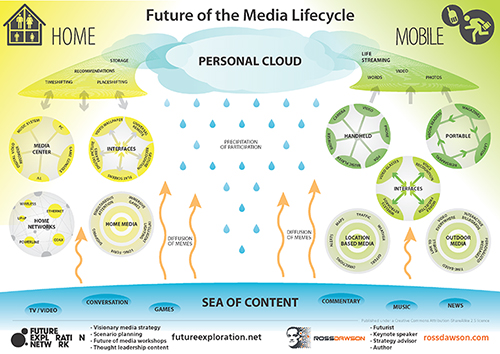The critical role of portable large screen devices in enabling mobile media
Michael Arrington of Techcrunch has just announced that they are trying to create the specifications to build a tablet computer primarily for web browsing for $200. The intention is to design it, then open source the design and software so anyone can build it, thus making an inexpensive web tablet available to many. More background from Nik Cubrilovic.
This directly addresses one of the key points in our Future of the Media Lifecycle framework, illustrated below (full explanation at the link).
The development of mobile media requires rich media devices. These come in two forms: handheld and portable. The iPhone and its emerging competitors have finally created a handheld interface which is a true media device that will encourage people to engage in a wide range of media consumption and creation activities. However there is still an important role for portable devices, that can’t be put in a pocket. While I’m a strong believer in the role of video glasses and similar interfaces that allow a handheld device to provide a wide visual screen, the reality is that in most cases people will want a normal flat screen. Before long rollable and foldable screens will fulfil this role. In the meantime a flat screen is both available, and will long have a cost advantage over e-paper-based screens. Laptops have a place, but have long boot times and are over-specified. eBooks will also be important, though are currently fairly application specific. A web tablet as described by Arrington would neatly fill an important space in having an inexpensive, flexible portable media device that will facilitate accessing the personal cloud that will be at the center of our lives.
On another level, this is a great example of open source innovation, in which consumers define what they want, create the model, and by making the design open source, ensure the product is commoditized and low cost. The highest value part of the process is performed by the customers, not the vendors.

